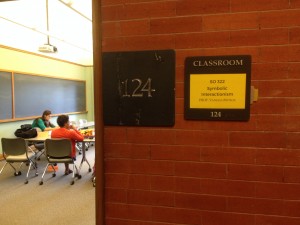New this year, CC’s Sociology department has changed the way we take our theory courses for requirements. In Block II, I took the general Social Theory Class with Professor Deb Smith and then elected to focus on Symbolic Interactionism for my specialized theory. Following this, I’ll take either Quantitative or Qualitative Methods and then write my thesis!

Symbolic interactionism is one of the major theoretical frameworks of modern Sociology, and focuses largely on micro-interactions between people of all sorts. It’s all about how we create meanings through interactions, and how, as Professor Vanessa Muñoz’s coffee cup quotes Charles Cooley, “Self and society are twin-born.” As far as class goes this week, we’ve read some philosophy regarding interactions: Mead’s “The Self,” Cooley’s “The Looking-Glass Self,” and Erving Goffman’s “The Presentation of Self in Everyday Life.” From this final book we read a good 100 pages overnight, and one of the main points Goffman made works to counter my title for this post: “All the world is not, of course, a stage, but the crucial ways in which it isn’t are not easy to specify.” In other words, we are all part of society that watches each other and assigns meanings to others’ appearance and demeanor, even though we are not technically on a stage. See the awesome Zits cartoon below for a contemporary example.

http://themetapicture.com/page/632/
In addition to the philosophy aspect of class, we have a field component that will culminate in a final research paper. Let me explain: in addition to reading/discussion, an ethnographic study done by student groups of five on a topic of choice is a large part of the syllabus. Ethnography is defined as the scientific description of the customs of individual peoples and cultures. My group of five women has decided to study the interactions of medical professionals with the general public in neutral spaces, specifically the hospital cafeteria. We have been visiting Penrose Hospital recently and have only begun to observe patterns of interactions that hint to the world of the cafeteria being a stage.

http://www.csbj.com/tag/penrose-st-francis/
For example, take the “costumes.” White labcoats, patient gowns, stethoscopes, ID badges… All of the characters are identifiable by what they wear in this way. Their appearances affect how people interact with each other in the cafeteria; for example, we sit with those who are like us and give space to those that merit respect. As a student that plans to go to medical school in a couple of years, it’s been interesting to start looking critically at the hierarchy of the hospital… Who are the doctors? Who cooks the food? What does it mean to be an RN versus a PA? What do subsets of employees talk about in their free time?
Obviously I’ve got a lot of questions about my ethnographic study, and I’m told that this is normal. Hopefully, in another week, my team’s observations will guide us to a specific research question and a theory – regardless of how blurry it is. Because Symbolic Interactionism works so neatly with ethnography – watching how people interact and create meanings is the way that we can more clearly theorize on dramaturgical interactions – I’m happy to say that I have no doubts that this first week has just been the beginning! I’m starting to see characters and costumes and stages instead of what I’ve always seen as just plain life… I’m thinking Goffman’s thoughts are on point.